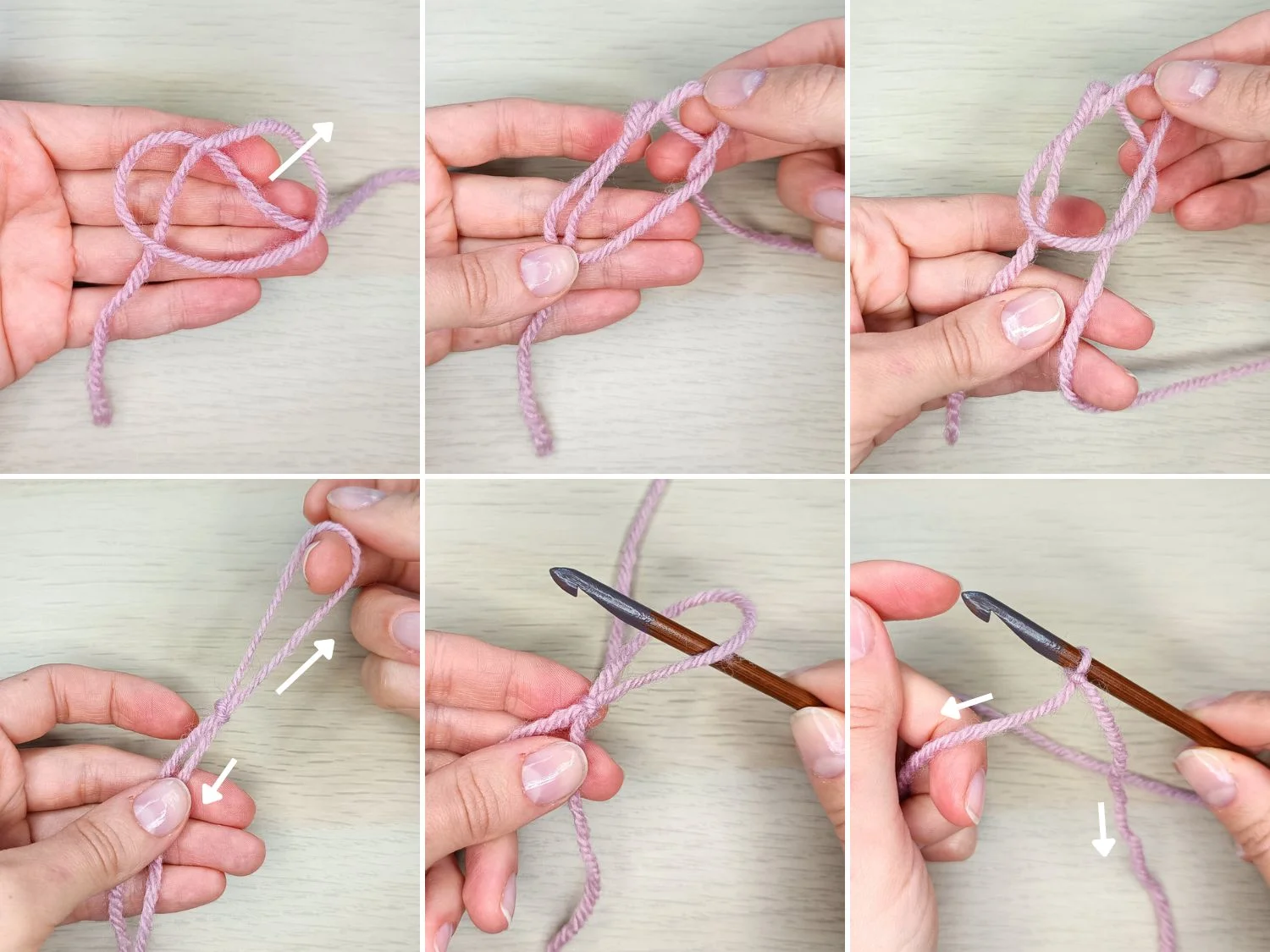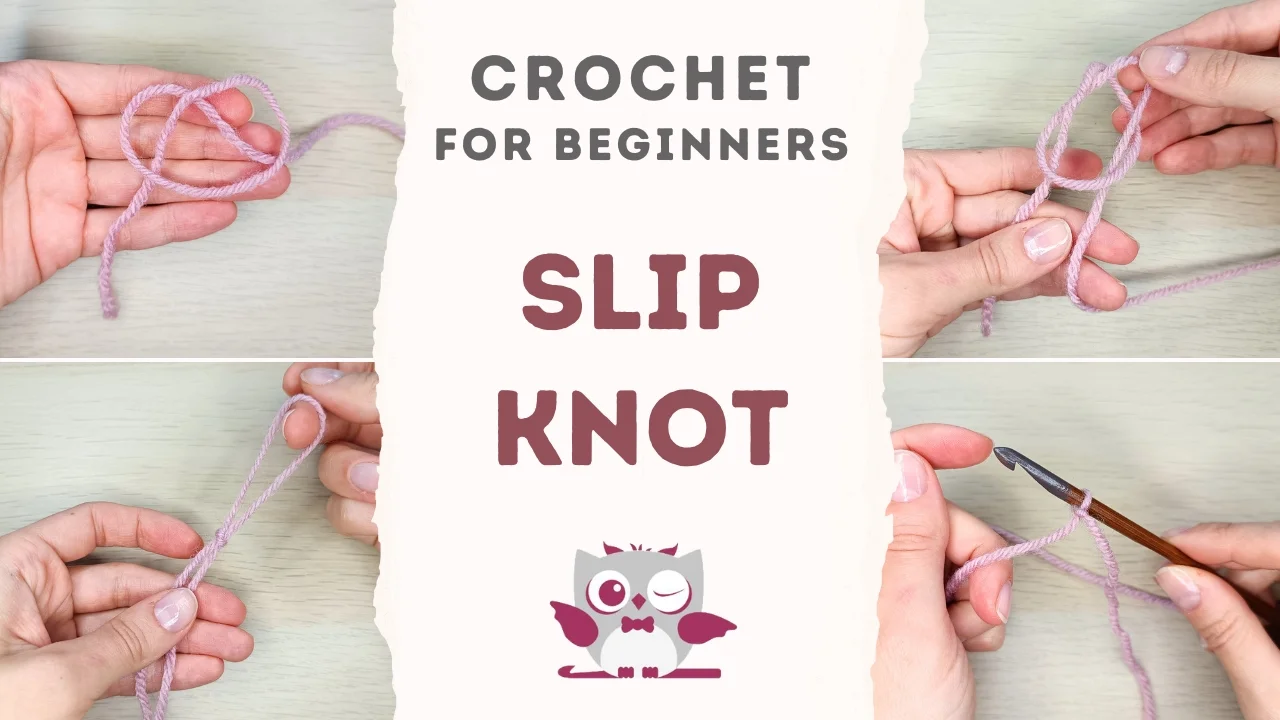In this article:
Welcome to our beginner-friendly tutorial on how to make the slip knot! This little loop is the foundation for almost every project. No matter if you are new to the crochet world, or just need a quick refresher – mastering it is the first step. Bring your yarn creations to life with this step-by-step guide and learn how to crochet with us.
We’ll walk you through the simple process of making a slip knot, so let’s dive in and get those creative hands ready!
What is a slip knot?
An adjustable knot is the fundamental technique in crochet, as it creates an adjustable loop on the crochet hook. It serves as the beginning of a project – the initial step. Without it, you can’t form subsequent crochet stitches.
What can I use it for?
A slip knot serves various purposes:
- Starting Point – It establishes the foundation for your crochet project by creating a loop on the hook.
- Initiating Color Changes – to start crocheting with the new color, it’s good to secure the yarn on the hook with a slip stitch first.
- Standing Stitches – an advanced method of adding standing stitches.
Learn How to Tie a Slip Knot
If you are wondering “How do I tie a slip knot?”, you’ll soon discover that tying a slip knot is easy to learn. Choose the way that suits you best – do you prefer a video tutorial, step-by-step photos, or written instructions?
Video
video tutorial by Crochetpedia for Your Crochet
Step-By-Step
Follow the steps and written instructions below. This method of creating an adjustable knot works for both right- and left-handed crocheters.

- Wrap the yarn so that it creates a pretzel-shaped loose knot. You can see the two diagonal lines inside the knot. Find the part closer to the working yarn.
- Pinch it with your fingers and pull up, holding the rest of the knot with your other hand.
- Keep both the yarn end and the working yarn with your other hand and pull.
- Tighten the knot.
- Insert your hook in the loop.
- Tighten the loop on the hook by pulling one of the strands (the yarn end or the working yarn).
Congratulations! You now have a slip knot and can start crocheting. The next step is to learn how to crochet a chain stitch.
Common Mistakes
Too Tight Knots
If the knot is hard to adjust or unravel, it means that you tied it too tightly. You may have problems inserting a hook in it when you reach the end of the row. Unravel it and make it again, but this time be mindful of tension. Keep it snug, but not tight.
Loose Knots
If the slip knot is too loose, it will slide on your hook – it might even slip or unravel during crocheting. Tighten the knot slightly by pulling the working yarn.
Can’t Pull The Working End
Sometimes you can feel the yarn resisting while pulling – especially if it’s a furry yarn, scratchy rope, or novelty yarn with boucle or knobs. First, ensure that the yarn end is free of tangles, and then pull the yarn gently for a smooth adjustment.
Tips for Creating a Slip Knot
- Practice tying slip knots regularly to improve your skills and develop a feel for the right tension.
- Avoid excess yarn – keep an eye on the appropriate length. If the tail is too long, it may create unnecessary tangles.
- Ensure the yarn has no tangles before starting.
- Don’t pull hard when adjusting the size of the slip knot. Rather, pull gently and make sure the tension is right.
- If it doesn’t work, undo it and start afresh because practice makes perfect.
Read more about this subject on our other websites
History of Slip Knot
Slip knot has a long history dating back to ancient times, and its simple yet functional design has been used in various cultures around the world. This basic and universal knot has been a crucial part of netting, sailing, and handicraft history throughout the ages. It has been used by various cultures around the world and is still used today.
Origins
Slip knot has no clear inventor or country of origin, as it’s one of the most basic knots. It has been independently discovered by different communities. This knot is a fundamental element of many sailing, fishing, and handicraft techniques, suggesting its wide use and ancient roots.
While its invention cannot be credited to any one person or culture, its versatility, and usefulness have made it an integral part of many crafts and everyday practices.
Early Uses
According to archeologists and historians, the slip knot was known and used in ancient Egypt and Greece. We find it used in a variety of contexts, from everyday work to religious ceremonies. This knot was also essential in sailing and fishing, where its ease of tying and untying was extremely valuable.
Historical Sources
There are no clear records indicating a specific inventor of the slip knot. However, this knot is described in many old sailing and handicraft manuals. One of the written sources is “The Ashley Book of Knots” by Clifford W. Ashley, published in 1944, which describes many knots, including the slip knot. The author describes it as:
“(…) a Stopper Knot that may be spilled or slipped instantly by pulling on the end to withdraw a loop. There is but one knot entitled to the name; any others having a similar feature are merely “Slipped” Knots.” *
He mentions the problem with the name “slip knot” throughout his book, as it was attributed to various tying techniques. Then, he treats the term “slip knot” as a name for the whole category of knots. In the Glossary section, he writes:
“Slip Knot: Any knot which may be spilled by pulling on the end, so withdrawing a loop.” *
Indeed, a slip knot without a crochet hook inside is very easy to adjust and untie. When tied around an object, however, it provides an adjustable and secure grip.
*the whole book is available on archive.org
Cultural Importance
Slip knot has its place in various traditions and cultures, and has been used in ceremonies and rituals. In some cultures, this knot has been used in wedding ceremonies, symbolizing connection and unity.
As you may expect, slip knot is also prevalent in handicraft history. It is a basic knot in many techniques, such as macrame and crochet.
FAQ
What materials can I use to make a slip knot?
You can create a slip knot with various yarns, including natural fibers, synthetic yarns, and ropes. It’s possible to make a slip knot with virtually any material and yarn weight.
Are there different variations of a slip knot?
The basic concept of a slip knot remains the same, but there are variations in how you form it. Some crocheters may prefer tying it with their hands and then inserting a hook in the loop. Others tie it with the use of a hook itself. Experiment with different methods to find the one that suits your style and preferences.
Can I use it for different purposes?
Sure, the slip knot is a versatile starting point in crochet, but you can also use it to solve everyday problems. The same slip knot is often used for tying rope while camping, fishing, or gardening.
Is a slip knot easy to untie?
Yes, the main advantage is its ease of untying. When you take the knot off the hook and pull the yarn end, it should unravel effortlessly.
How secure is a slip knot?
If the slip knot is tied properly, it’s secure enough to keep the yarn on the crochet hook. However, its primary advantage is the easiness with which one can adjust it or untie it.
How do I adjust the size of a slip knot?
You adjust it by gently pulling on the working yarn, or the yarn end. To make it larger, you have to pull the loop.
Are there any alternatives to a slip knot?
Yes, there are other methods of starting crochet projects, such as the magic ring. We often use it in amigurumi projects. It offers an adjustable starting point without a knot, but you use it for working in the round.
Summary
As you can see, learning how to tie a slip knot is easy. We hope that these step-by-step instructions and video tutorials make it even easier for you. Remember that an adjustable knot is a crucial part of any crochet project.
You are now ready to learn chain stitches, single crochet, and double crochet.


![How to Make a Slip Knot [Video Tutorial for Beginners]](https://yourcrochet.com/wp-content/themes/kadence-child/assets/new/img/page-banner.png)



I appreciate your tutorials. They are clear, simple and to the point. Now I can finally tie a slip knot!